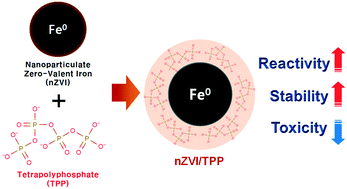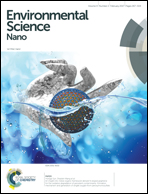Nanoparticulate zero-valent iron coupled with polyphosphate: the sequential redox treatment of organic compounds and its stability and bacterial toxicity†
Abstract
Nanoparticulate zero-valent iron (nZVI) coupled with tetrapolyphosphate (TPP) (nZVI/TPP) was examined for the degradation of organic compounds, such as trichloroethylene (TCE), pentachlorophenol (PCP), and phenol, and the effects of TPP on the stability and toxicity of nZVI were studied. A sequential redox treatment (i.e., anoxic followed by oxic treatment) was attempted as a means to improve the utilization of nZVI for compound degradation. In the first anoxic treatment, chlorinated organic compounds, such as TCE and PCP, were degraded reductively by electron transfer from nZVI to the compounds at relatively slow rates. In the following oxic treatment, all organic compounds were rapidly degraded by the reactive oxidant (Fe(IV) species) produced via the reaction of the Fe(II)–TPP complexes with oxygen. In both anoxic and oxic treatment stages, the nZVI/TPP system exhibited greater activity in the degradation of organic compounds than that of nZVI alone. The anoxic/oxic reactivity of nZVI/TPP was affected by the pH and nZVI dose. The coupling of nZVI with TPP also enhanced the stability of nZVI; TPP was observed to inhibit the agglomeration and sedimentation of nZVI. In addition, the bacterial toxicity of nZVI and its oxidation products (i.e., Fe(II) and Fe(III)) was significantly reduced by the addition of TPP; TPP lowered the degree of E. coli inactivation by nZVI and its products, mitigating cell membrane damage.


 Please wait while we load your content...
Please wait while we load your content...